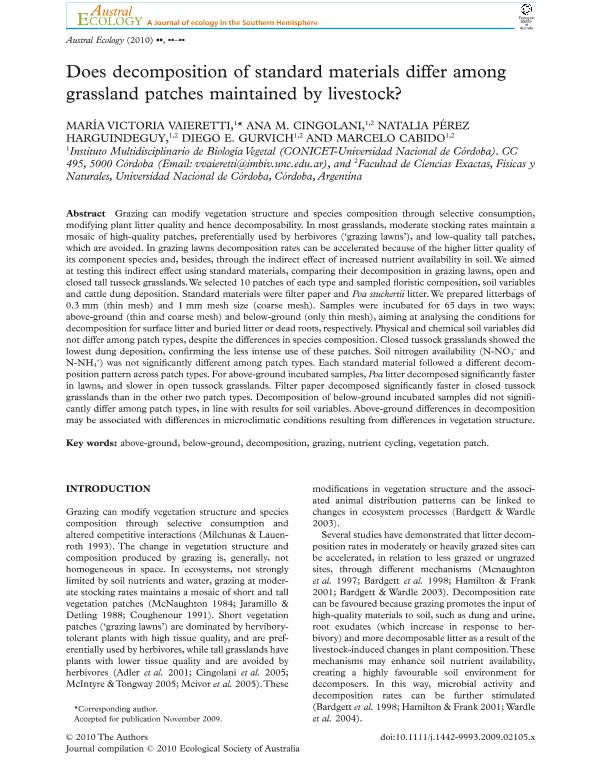Artículo
Does decomposition of standrd materials differ among grassland patches maintained by livestock?
Vaieretti, Maria Victoria ; Cingolani, Ana María
; Cingolani, Ana María ; Perez Harguindeguy, Natalia
; Perez Harguindeguy, Natalia ; Gurvich, Diego Ezequiel
; Gurvich, Diego Ezequiel ; Cabido, Marcelo Ruben
; Cabido, Marcelo Ruben
 ; Cingolani, Ana María
; Cingolani, Ana María ; Perez Harguindeguy, Natalia
; Perez Harguindeguy, Natalia ; Gurvich, Diego Ezequiel
; Gurvich, Diego Ezequiel ; Cabido, Marcelo Ruben
; Cabido, Marcelo Ruben
Fecha de publicación:
05/2010
Editorial:
Wiley
Revista:
Austral Ecology
ISSN:
1442-9985
e-ISSN:
1442-9993
Idioma:
Inglés
Tipo de recurso:
Artículo publicado
Clasificación temática:
Resumen
Grazing can modify vegetation structure and species composition through selective consumption, modifying plant litter quality and hence decomposability. In most grasslands, moderate stocking rates maintain a mosaic of high-quality patches, preferentially used by herbivores (‘grazing lawns’), and low-quality tall patches, which are avoided. In grazing lawns decomposition rates can be accelerated because of the higher litter quality of its component species and, besides, through the indirect effect of increased nutrient availability in soil. We aimed at testing this indirect effect using standard materials, comparing their decomposition in grazing lawns, open and closed tall tussock grasslands. We selected 10 patches of each type and sampled floristic composition, soil variables and cattle dung deposition. Standard materials were filter paper and Poa stuckertii litter. We prepared litterbags of 0.3 mm (thin mesh) and 1 mm mesh size (coarse mesh). Samples were incubated for 65 days in two ways: above-ground (thin and coarse mesh) and below-ground (only thin mesh), aiming at analysing the conditions for decomposition for surface litter and buried litter or dead roots, respectively. Physical and chemical soil variables did not differ among patch types, despite the differences in species composition. Closed tussock grasslands showed the lowest dung deposition, confirming the less intense use of these patches. Soil nitrogen availability (N-NO3- and N-NH4+) was not significantly different among patch types. Each standard material followed a different decomposition pattern across patch types. For above-ground incubated samples, Poa litter decomposed significantly faster in lawns, and slower in open tussock grasslands. Filter paper decomposed significantly faster in closed tussock grasslands than in the other two patch types. Decomposition of below-ground incubated samples did not significantly differ among patch types, in line with results for soil variables. Above-ground differences in decomposition may be associated with differences in microclimatic conditions resulting from differences in vegetation structure.
Palabras clave:
Above-Ground
,
Below-Ground
,
Decomposition
,
Grazing
Archivos asociados
Licencia
Identificadores
Colecciones
Articulos(IMBIV)
Articulos de INST.MULTIDISCIPL.DE BIOLOGIA VEGETAL (P)
Articulos de INST.MULTIDISCIPL.DE BIOLOGIA VEGETAL (P)
Citación
Vaieretti, Maria Victoria; Cingolani, Ana María; Perez Harguindeguy, Natalia; Gurvich, Diego Ezequiel; Cabido, Marcelo Ruben; Does decomposition of standrd materials differ among grassland patches maintained by livestock?; Wiley; Austral Ecology; 35; 8; 5-2010; 935-943
Compartir
Altmétricas



